Learn how to make the iconic Milanese cutlet, a classic Italian dish from Milan made with veal, breadcrumbs, and clarified butter for the perfect golden crust.
Embark on a culinary journey to the heart of Italy with the classic Milanese cutlet, or “Cotoletta alla Milanese”. This iconic dish, originating from the bustling city of Milan, has captivated food enthusiasts for generations. As you delve into the rich history and meticulous preparation of this beloved recipe, you’ll discover the secrets behind its crispy exterior and tender, juicy center. From selecting the perfect cut of veal to mastering the art of breading and frying, you’ll learn how to recreate this timeless Italian delicacy in your own kitchen.
As with many traditional recipes, there is no single definitive version of “Cotoletta alla Milanese”. Different families in the Milan area often have their own small variations on the dish. The recipe I am sharing with you today is one I learned from a chef friend who hails from Milan. I’ve had great success making it following his instructions. Prepare to impress your guests and transport them to the streets of Milan with every succulent bite.
Milanese Cutlet Video Recipe
The History and Origin of Milanese Cutlets
A Culinary Legacy
The Milanese cutlet, known in Italian as “cotoletta alla milanese”, boasts a rich history dating back to the 12th century. It won’t surprise you to learn that this iconic dish originated in Milan, Italy, where it has been a staple of Lombard cuisine for centuries. The cutlet’s creation is often attributed to the Milanese aristocracy, who sought to elevate simple peasant fare into a more refined culinary experience.
Evolution and Controversy
As you delve deeper into the cutlet’s history, you’ll discover an intriguing controversy surrounding its origins. Some food historians argue that the Milanese cutlet predates the similar Viennese schnitzel, while others contend that the two dishes evolved independently. The historical dispute between Milanese and Viennese regarding the origins of the breaded cutlet dish was definitively resolved in favor of the former, based on a report addressed from Count Attems to Emperor Franz Joseph, in which the earliest known mention of the Milanese-style breaded cutlet is cited. Field Marshal Radetzky would then have personally provided the recipe to the emperor himself. Regardless of its precise origins, the Milanese cutlet has undoubtedly left an indelible mark on Italian gastronomy.
Traditional Preparation
Traditionally, you would prepare a Milanese cutlet using a thick cut of veal loin, complete with the bone intact. This distinctive preparation method sets it apart from other breaded cutlets. The meat is typically pounded thin, coated in egg and breadcrumbs, and then fried in clarified butter. This cooking technique results in a crispy exterior and a tender, juicy interior that has captivated diners for generations.
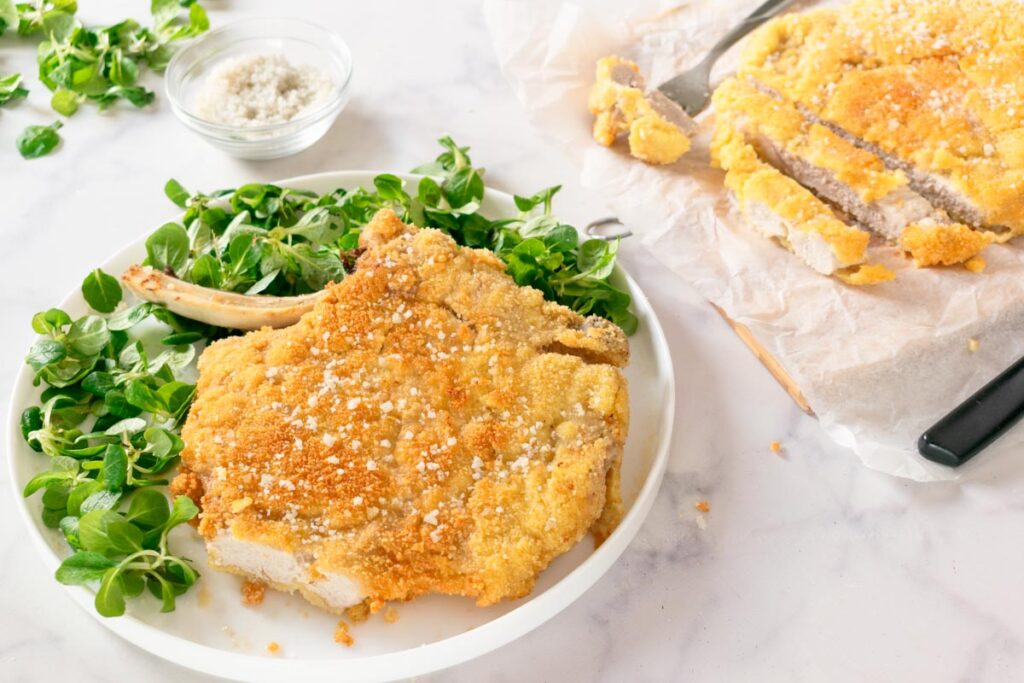
Ingredients Needed to Make Milanese Cutlets
To prepare authentic Milanese cutlets, you’ll need a carefully curated selection of high-quality ingredients. Each component plays a crucial role in achieving the dish’s signature crispy exterior and tender interior.
- 4 veal loin cutlets (about 3 cm thick) – The cutlet must necessarily be obtained from the loin (or rib) of young veal; some believe that only the first six ribs have the characteristics necessary to aspire to breading: only these, in fact, are neither too lean nor too fatty and sufficiently tender to be fried without having to beat or weaken them with prolonged handling as was done in the past. The handle, that is, the bone of the rib protruding from the meat, is usually covered with aluminum foil to allow diners to suck it by taking it between their fingers.
- 3 eggs – The eggs act as a binding agent, ensuring the breadcrumbs adhere properly to the meat.
- 200 g breadcrumbs (about 4½ cups).
- 450 g clarified butter (4 sticks) – A key element in preparing Milanese cutlets is the cooking fat. You’ll need 450 grams of clarified butter, which is essential for achieving the desired crispy texture. Clarified butter has a higher smoke point than regular butter, allowing you to fry at higher temperatures without burning. This results in a drier, more satisfying crust while maintaining the meat’s juiciness.
- Coarse grey Sel de Guerande or flake salt – While the ingredient list is relatively simple, don’t overlook the importance of this salt. A judicious amount of salt enhances the natural flavors of the veal and complements the rich, buttery coating. I love using Guérande salt, also known as gray salt, when preparing Milanese cutlets. The distinctive crunch this salt provides with each bite of the juicy meat enhances the dining experience. Maldon salt, or flake salt, is another suitable option that also offers an appealing visual presentation when used to season cutlets prior to serving. Both salt varieties contribute noteworthy textures and flavors, making them worthwhile considerations when developing recipes that feature cutlets as a key ingredient.
Step-by-Step Instructions for Preparing Milanese Cutlets
Milanese-style veal cutlets are prepared using the veal loin chop, complete with the bone. Proper cut is the first rule, the second is pan-frying in clarified butter, which has a higher smoke point allowing it to be cooked at a higher temperature resulting in a drier outcome.
Preparation of the Veal
Begin by selecting high-quality veal loin cutlets, approximately 3 cm thick. Trim any visible external fat and connective tissue from the meat. To prevent curling during cooking, score the edges of each cutlet in 2-3 places. Gently pound the meat to ensure even thickness. You can have your trusted butcher do this job.
Breading Process
Beat the eggs in a bowl. Dip each cutlet into the beaten eggs, holding it by the bone. Drain the egg well (1), then coat the cutlet well with breadcrumbs, making sure to coat evenly on all sides. Keep the bone clean and free of breading. Using the back of a kitchen knife or a spoon, lightly press the breaded surface in a grid pattern to promote adherence and prevent air bubbles during frying (2). Dip in the egg again and coat in breadcrumbs, so that each cutlet is double-breaded.
Frying the Cutlets
In a large, heavy pan, melt 450 g of clarified butter. Once hot, carefully place the breaded cutlets into the pan (3). Cook over high heat for 2-3 minutes per side, until golden brown. While frying, spoon some hot butter over the bone to ensure even cooking (4). The ideal Milanese cutlet should be crispy on the outside and tender on the inside.
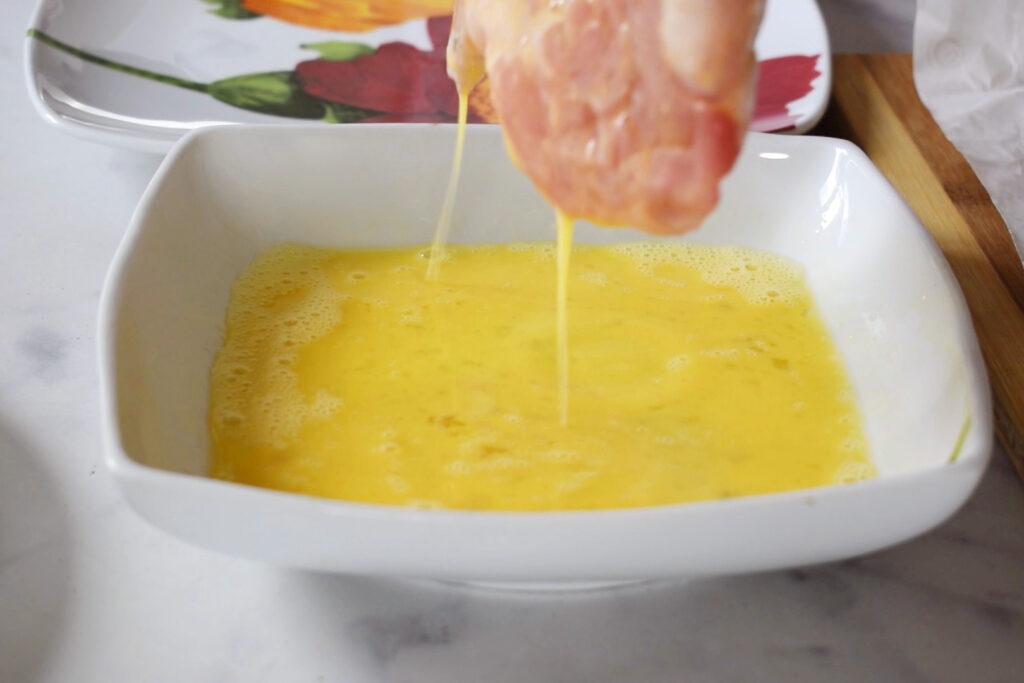
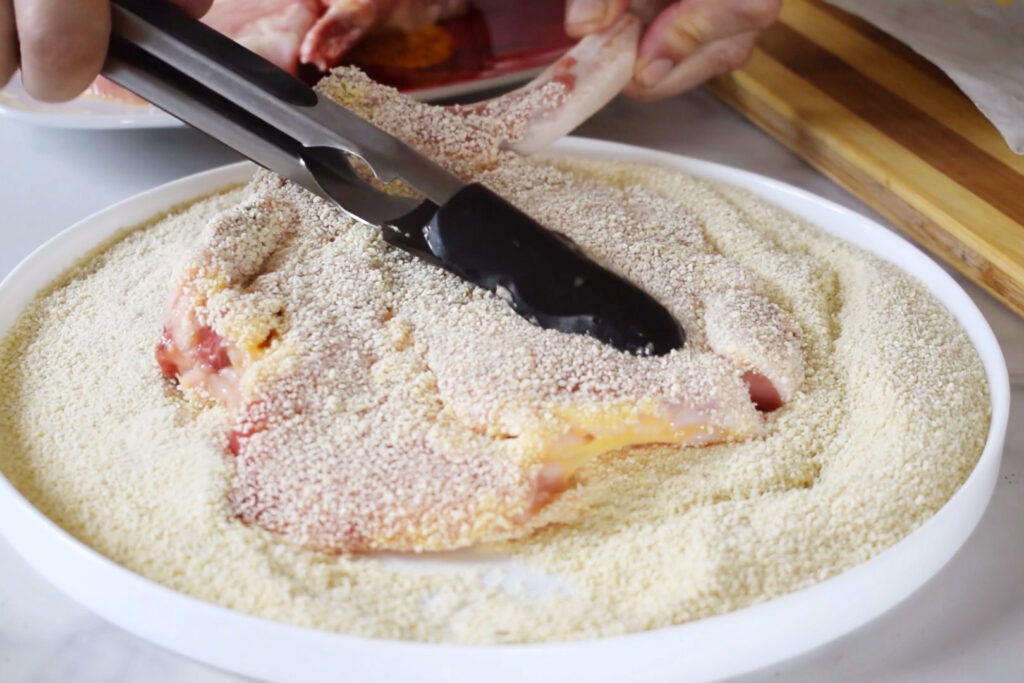
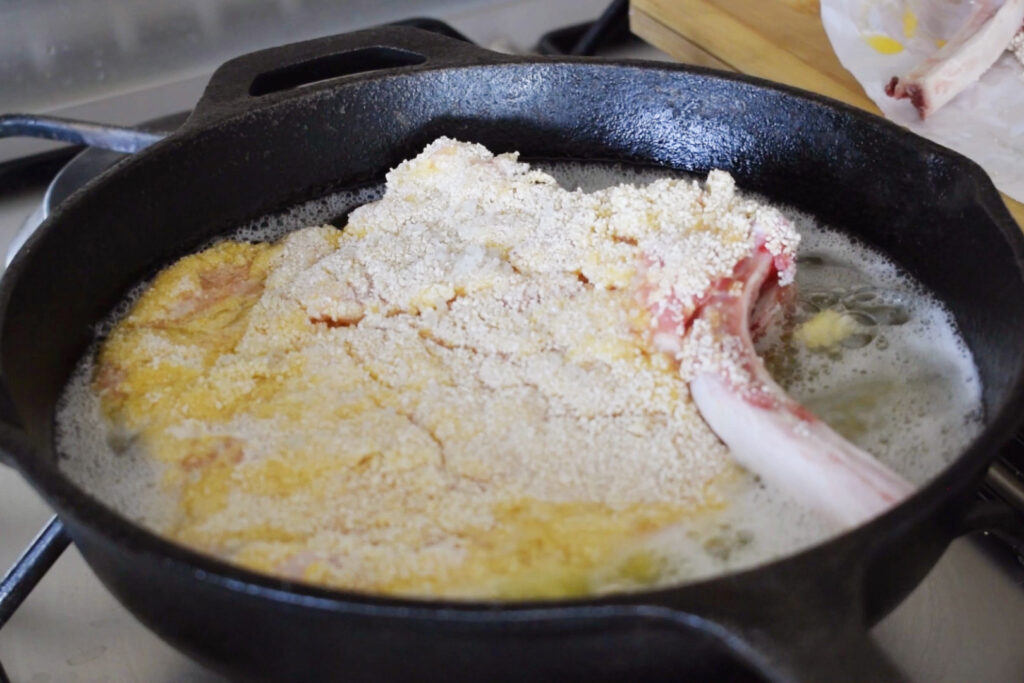
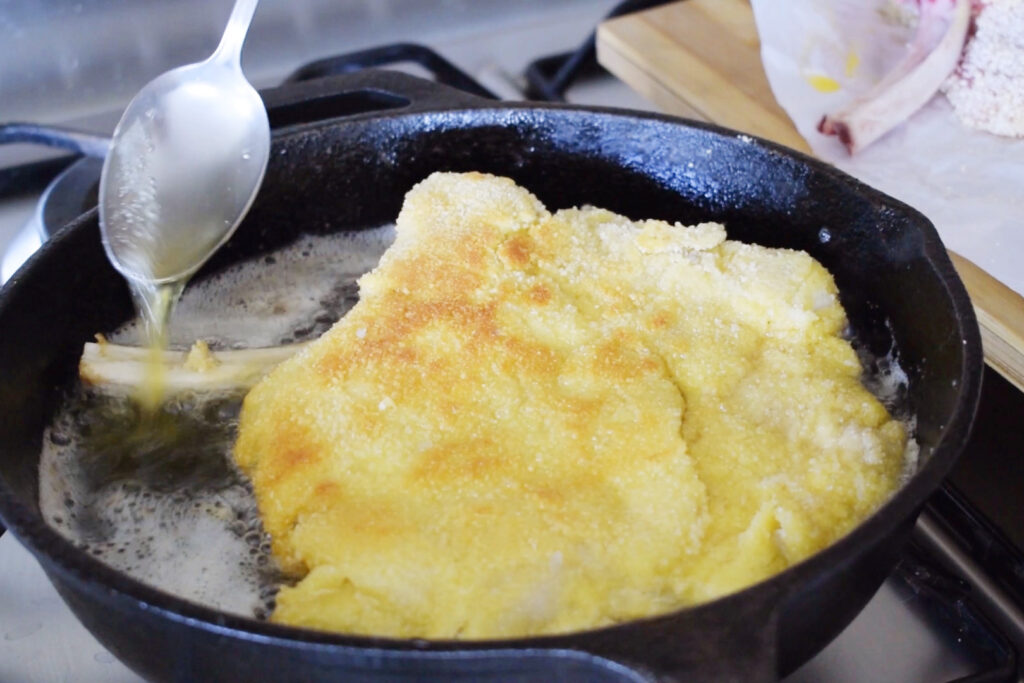
Serving
Once cooked, transfer the cutlets to a wire rack or paper towels to drain excess butter. Sprinkle with salt flakes to taste. Serve immediately with a side of fresh salad or baked potatoes for a classic Italian dining experience. Remember, when cut, the interior should be slightly moist, showcasing the perfect balance of textures that defines this iconic dish.
Serving Suggestions for Milanese Cutlets
Classic Accompaniments
When serving Milanese cutlets, you’ll want to pair them with sides that complement their rich, crispy texture. A traditional accompaniment is a simple arugula salad dressed with lemon juice and olive oil. The peppery greens and bright citrus notes provide a refreshing contrast to the hearty cutlet. Alternatively, you might consider serving roasted or mashed potatoes, which offer a comforting element to balance the dish.
Seasonal Variations
To elevate your Milanese cutlet presentation, consider incorporating seasonal vegetables. In spring, asparagus spears lightly grilled with a touch of garlic make an excellent side. During summer months, a medley of grilled zucchini, eggplant, and bell peppers can add vibrant colors and flavors to your plate. For autumn, roasted butternut squash or sautéed wild mushrooms provide earthy notes that pair wonderfully with the veal.
Sauces and Garnishes
While Milanese cutlets are traditionally served without sauce, you may choose to offer a small ramekin of lemon wedges on the side. This allows diners to add a squeeze of citrus if desired, enhancing the cutlet’s flavors. For a more indulgent touch, consider serving a small dollop of garlic aioli or a light tomato sauce on the side. Remember to garnish the plate with fresh herbs like parsley or basil for added aroma and visual appeal.
Milanese Cutlet Wine Pairing
When savoring a perfectly prepared Milanese cutlet, you’ll want to complement its rich flavors with an equally impressive wine. Your choice of wine can elevate the dining experience, enhancing the dish’s crispy exterior and tender, juicy interior.
White Wine Selections
For a classic pairing, you should consider a crisp, medium-bodied white wine. A Pinot Grigio from northern Italy, with its bright acidity and subtle fruit notes, can cut through the richness of the fried cutlet. Alternatively, you might opt for a Soave, another Italian white that offers a pleasant minerality and almond undertones, perfectly balancing the dish’s savory elements.
Red Wine Options
If you prefer red wine, select a light to medium-bodied variety that won’t overpower the delicate veal. A young Barbera d’Asti, with its vibrant acidity and red fruit flavors, can provide a delightful contrast to the breaded cutlet. For a more robust option, you might choose a Valpolicella Classico, whose cherry notes and subtle spiciness can complement the dish’s golden-brown crust.
Sparkling Alternatives
Don’t overlook the potential of sparkling wines. A dry Prosecco or Franciacorta can offer a refreshing counterpoint to the richness of the Milanese cutlet. The effervescence helps cleanse your palate between bites, ensuring each mouthful is as enjoyable as the first.
Remember, the key to a successful pairing is balance. Your chosen wine should enhance, not overpower, the flavors of your meticulously prepared Milanese cutlet.
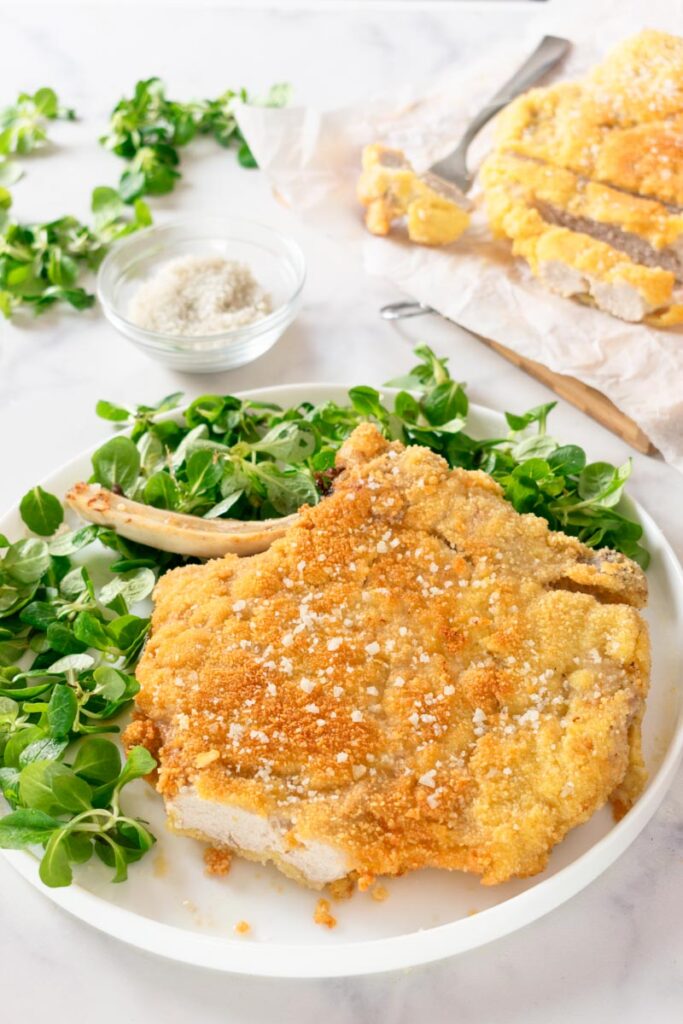
Milanese Cutlets Recipe FAQs
What cut of meat is best for Milanese cutlets?
For authentic Milanese cutlets, you should use veal loin cutlets, approximately 3 cm thick. The loin cut, complete with the bone, is traditional and provides the best texture and flavor. If veal is unavailable, you can substitute with pork loin chops, though the taste will differ slightly from the classic recipe.
Why use clarified butter for frying?
Clarified butter is essential for achieving the perfect Milanese cutlet. It has a higher smoke point than regular butter, allowing you to fry at higher temperatures. This results in a crispier exterior while maintaining a juicy interior. Additionally, clarified butter imparts a rich, nutty flavor that enhances the overall taste of the dish.
How do I prevent the cutlets from curling during cooking?
To prevent curling, score the edge of the cutlet in 2-3 places before cooking. This technique helps the meat maintain its shape during the frying process. Additionally, pressing lightly on the breaded cutlet with the back of a kitchen knife, creating a grid pattern, will help the breading adhere better and reduce air bubble formation.
What’s the ideal cooking time for Milanese cutlets?
For the perfect balance of crispy exterior and tender interior, cook the cutlets over high heat for approximately 2-3 minutes per side. Remember to also spoon hot butter over the bone during cooking. The cutlets should be golden brown on the outside and slightly moist inside when done.

How to Make Milanese Cutlets: A Classic Italian Recipe
Ingredients
- 4 medium-sized veal loin cutlets about 3 cm thick, or 2 large
- 3 eggs
- 200 g breadcrumbs
- 450 g clarified butter
- Coarse grey salt or Flake salt to taste
Instructions
- Begin by selecting high-quality veal loin cutlets, approximately 3 cm thick. Trim any visible external fat and connective tissue from the meat. To prevent curling during cooking, score the edges of each cutlet in 2–3 places. Gently pound the meat to ensure even thickness (You can have your trusted butcher do this job).
- Beat the eggs in a bowl.
- Dip each cutlet into the beaten eggs, holding it by the bone. Drain the egg well, then coat the cutlet well with breadcrumbs, making sure to coat evenly on all sides. Keep the bone clean and free of breading.
- Using the back of a kitchen knife, lightly press the breaded surface in a grid pattern to promote adherence and prevent air bubbles during frying.
- Dip in the egg again and coat in breadcrumbs, so that each cutlet is double-breaded.
- In a large, heavy pan, melt 450 g of clarified butter. Once hot, carefully place the breaded cutlets into the pan. Cook over high heat for 2–3 minutes per side, until golden brown. While frying, spoon some hot butter over the bone to ensure even cooking. The ideal Milanese cutlet should be crispy on the outside and tender on the inside.
- Once cooked, transfer the cutlets to a wire rack or paper towels to drain excess butter.
- Sprinkle with salt to taste.
- Serve immediately with a side of fresh salad or baked potatoes for a classic Italian dining experience.







